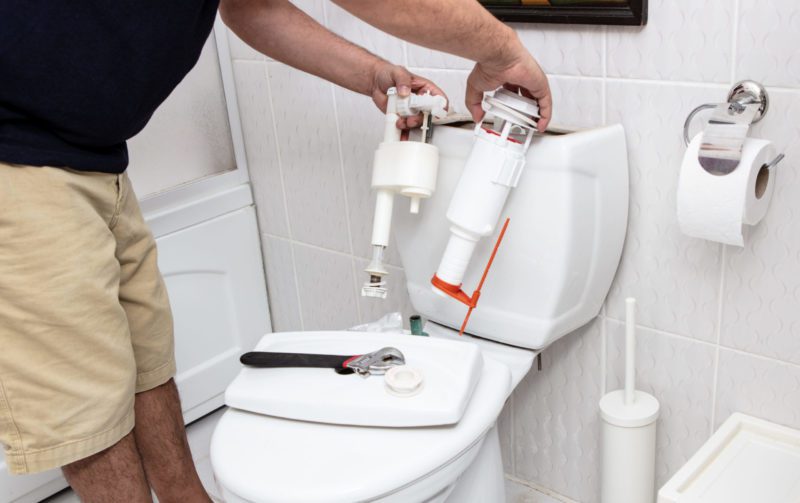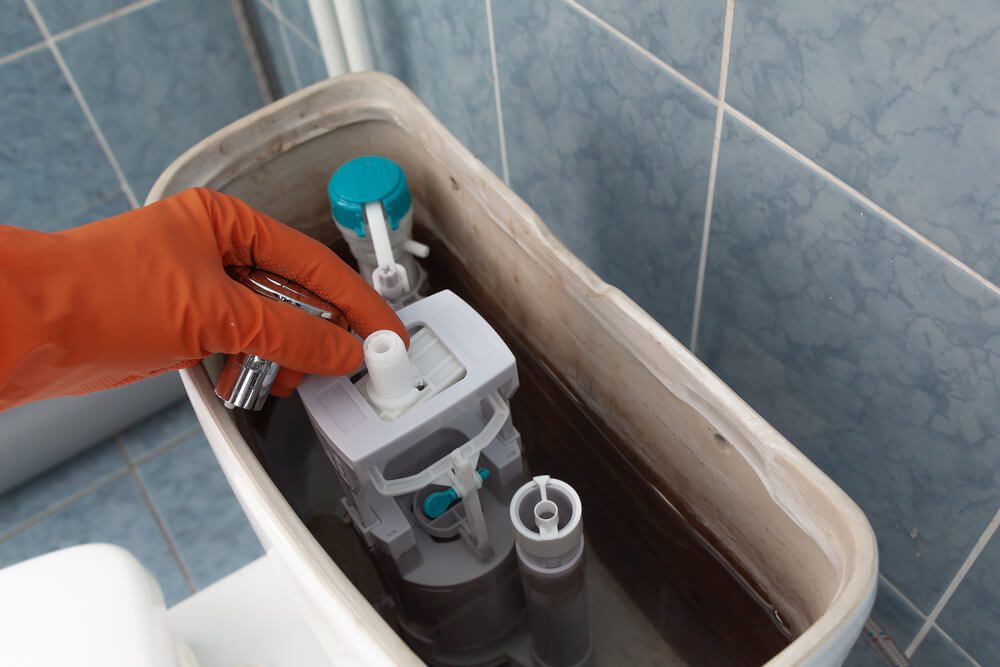Troubleshooting Toilet Issues: Tips and Solutions
Minor toilet troubles are common occurrences in homes. Luckily, troubleshooting toilet issues is relatively easy when problems are simple. With the right know-how, you can solve your bathroom problem quickly and without a service call to your plumber.
The licensed plumbers of Apollo Home explain how to fix common toilet problems and which common commode conundrums that are best left for professionals to handle. If your Cincinnati home has toilet troubles that these tips don’t solve, give us a call to schedule service.

Man using tools repairing reservoir in a bathroom in a concept of DIY repairs with copy space
Toilet Constantly Runs
If your toilet keeps running, the problem is probably a leaky flapper in the bottom of the tank or a defective fill or float valve. In addition to the annoyance of listening to a running toilet and jiggling the handle to stop it, you’re wasting valuable water. Remove the toilet tank lid to solve the issue.
- If the tank is empty, check to see if something is holding the round rubber flapper valve in the bottom of the tank open. If the toilet flapper won’t go down, it could be a snarled flush chain you can untangle yourself, or the valve itself may have deteriorated and fallen to pieces. Replacing the flapper valve is a simple DIY task, or it can be left to a professional.
- If your toilet tank keeps filling up with water and spilling water down the overflow tube, then try adjusting the float valve downward to stop the toilet tank from filling so high. If the float valve will not move, it needs to be replaced. If water continues to spill into the overflow tube, it’s a sign of a defective fill valve.
Skip troubleshooting and call a plumber to tackle this repair if:
- Water flows into the overflow tube in the back of the tank.
- The tank refills very slowly.
- The tank does not fill, which indicates a failed fill valve.
- Water leaks or sprays from around the float valve cap or plunger.
Toilet Runs On and Off Intermittently
If your toilet sometimes runs water without flushing, this issue is often caused by a slow leak from the tank into the bowl. Fixing this problem focuses on the flapper:
- A leaky flapper valve causes leaks into the toilet. Make sure the flapper is able to form a tight seal at the base of the tank. Sometimes, mineral buildup or toilet cleaning tablets may prevent a good seal and need to be cleaned away.
- If the flapper itself is damaged, replace it yourself or call your plumber to do so.
Other causes of this intermittent toilet running problems that require a plumber’s assistance include:
- A defective fill valve may actuate intermittently and needs to be replaced.
- A defective donut gasket between the tank and toilet bowl is another possible source of this type of leak.
- Cracks in the tank also cause leaks into the bowl. In this case, the toilet needs to be replaced.
Weak, Slow, or Partial Flushes

If your toilet flushes weakly, slowly, or only partially, then it could be caused by a few toilet problems. Follow these tips related to fix a toilet’s weak, slow, and partial flushes:
- The flapper may be closing too soon. If there’s too much slack in the operating chain, the flapper may not open fully and then close too quickly without releasing enough water from the tank. Take off the lid, push the flush handle, and observe the operation. The flapper should stay open until about 80 percent of the water in the tank has flushed into the toilet bowl. If not, take up a few links of slack where the flush chain attaches to the flush handle and try again.
- If the flapper has deteriorated and is waterlogged, it’s time to replace the flapper.
- The water level in the toilet tank may be too low. Adjust the float valve upward to raise the tank fill level.
Issues that require a plumber’s help include:
- The bowl’s rim jets at the inner edge of the bowl or the main flushing jet may be clogged with hard water scale or debris. A plumber’s solutions include pouring muriatic acid into the system to clean out the clogs or using a pointed tool to physically clear the holes.
- If the issue is a partially blocked drain line, the next flush could cause a complete blockage and result in an overflow. To prevent this, a plumber is needed to identify and correct the issue.
Water Leaks at the Floor
If water is slowly leaking from the bottom of the toilet, that usually means the wax seal between the base and sewer line flange needs to be replaced.
If there’s water leaking on the floor around the toilet, the rubber washer on the fill valve bolt or tank bolt has likely cracked, allowing water to drip out.
These fixes require taking apart the entire toilet, which needs to be performed by a plumber.
Toilet Is Unstable
If the entire toilet itself moves, shakes, or tilts in any direction when someone sits on it, the grout between the toilet and the floor may be missing or weakening. The anchor bolts holding the toilet to the floor may also be weak or coming loose, especially if the flooring itself has been damaged by water.
Grout can be replaced, and anchor bolts can be tightened. If the floor is damaged, it may be necessary to replace some sections of flooring.
Clogged Toilet
If the toilet won’t flush, there’s a clog or blockage in the trap or drain line. Use a plunger to force the clog through the line.
- Turn off the toilet’s water supply at the shutoff valve located on the wall behind it.
- Remove the tank lid and push the flapper shut to prevent water from filling the bowl.
- If the bowl is nearly overflowing, use a bucket to remove excess water.
- Insert a flanged toilet plunger into the drain hole, forming a tight seal.
- Plunge up and down for about 20 seconds, then quickly remove the plunger.
If plunging the toilet doesn’t clear the clog so the water drains out of the bowl, avoid flushing the toilet as this can cause a messy overflow. Call a licensed plumber, who uses a toilet snake or auger to clear the blockage when troubleshooting does not work.
When to Replace Your Toilet
In certain situations, it is best to go ahead and replace your toilet:
- Breakage And Leaks: When the porcelain bowl or tank leaks from cracks or other damage, toilet replacement is generally the only viable option. Ongoing leakage may cause severe damage to the flooring and wooden structure of the home, requiring expensive repair.
- Excess Water Use: Toilets manufactured and installed prior to 1992 can be assumed to use no less than 5 gallons-per-flush (GPF) and many use as much as 7 GPF. New low-flush toilets are required to use no more than 1.6 gallons per flush (gpf). Some high-efficiency toilet models consume as little as 1.28 GPF, cutting toilet water consumption by as much as 75 percent.
- Aesthetics: If you’ve changed the design or color scheme in your bathroom, that old-school ’80s toilet may clash with your new decor.
- Defective Components: If interior mechanisms like fill valves, floats, and handles are worn out or corroded, consider the cost of individual replacement versus simply upgrading to a new toilet.
- Renovation or Floor Replacement: If you’re considering a major bathroom rehab, you’ll have to pull the old toilet anyway. Instead of reinstalling the low-efficiency, water-wasting model, now may be the most convenient time to upgrade to a more efficient, money-saving toilet.
Toilets are heavy, securely installed, and require connection to an active water supply line. In most cases, toilet replacement isn’t a recommended DIY project and should be left to a professional with the expertise and specialized tools to do the job. Call your plumber to have the job done right.
Call Apollo Home for Toilet Repair
If troubleshooting does not solve the problem, it’s time to call a professional. The licensed Cincinnati plumbers of Apollo Home can attend to your toilet plumbing issues right away to repair damaged components and clear the issues that stand in the way of proper function. Contact us today to schedule service.
